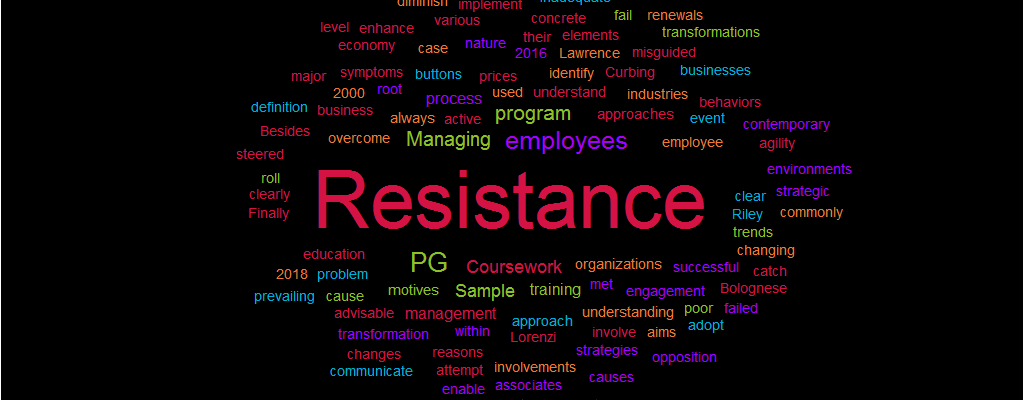Coursework Sample: Managing Change Resistance
Publication Date:

Introduction
The changing business environments have made various organizations to enhance their agility to catch up with the prevailing trends. The nature of the contemporary economy has steered several changes within businesses, but some of these changes are always met with resistance from employees. Resistance is one of the major reasons why many transformations always fail. Inadequate change definition and poor employee involvements are some of the reasons why organizations commonly experience resistance during strategic renewals. However, there are strategies that the management can adapt to overcome and diminish such level of resistance. PG industries, in its attempt to roll a new training program, are faced with the challenge of change resistance, and for it to overcome the menace, it can use approaches such as the active employee engagement and associates education. This works aims to identify the approaches that can be used by PG industries to overcome the resistance that has been met by its new training program.
Approaches for Curbing Change Resistance
To develop a successful solution to a problem, one must first be able to exclusively understand the problem in place and its root causes. Therefore, in the case of PG, the first appropriate approach would be to understand the core causes of the employees’ resistance. Relying on the symptoms of the resistance alone cannot be an adequate base of understanding the opposition since some symptoms are not always reflective. Understanding the root cause of the change opposition would enable PG, to identify the motives and the nature of resistance. Thereby, enabling the executive to identify and take the most accurate course of actions that would aim to completely eradicate the actual problem and prevent the probability of further occurrence (Lorenzi & Riley, 2000). Besides, a clear understanding of the cause of resistance would enable PG to avoid overindulging in strategies that may not possibly solve the situation.
The management of PG industries should clearly communicate the importance of the change process to the employees resisting the transformation. This can be achieved by objectively defining the training program and pointing out how the program is not only significant to the organization, but also to employees. The strategy should be accompanied by customized education that aims to encourage and inspire the employees to become part of the new training program. By effectively communicating the elements and the designs of the program to the employees and offering an education on the same, the opponents of change would get to understand the rationality behind the process (Lawrence, 2016). In consequence, they would be motivated to adopt it. PG should ensure that there are clear communication channels during the process.
Furthermore, active engagement of the employees who are opposed to the change is also an approach that PG can use to mitigate the current resistance. PG should involve the employees in making decisions that relate to the elements of the new training programs. By so doing, the employees would feel much bought into the change process, and as a result, they would own the process and stimulate its success (Bolognese, 2018).
Finally, viable ideas from the employees should be incorporated by PG into the new training program to make them feel part of the program. Though, the extents of the participation must be restrained. In an event that the resistance motives are malicious and misguided, it would be advisable for the PG management to adopt concrete steps. According to Lawrence (2016), in such an event, the management can implement and emphasize on a new standard that limits the behaviors of the employees and any misguided attempt of crippling the program should be met with consequences. This is an approach that should only be used by PG after understanding the motives of the resistance. Besides, this concrete approach is only valid in cases where communication and active involvements have failed.
Conclusion
Change resistance is one of the key challenges to a successful transformation within organizations. Some resistance may be negative while others may be positive, so, it is advisable for the organizations to understand the root cause of the resistance and the motives that drive such oppositions before taking any measure. In the case of PG which is facing oppositions from the employees regarding the new program, it is advisable for the management to clearly communicate the need for change to the associates and actively involve them. In events where other approaches of curbing resistance have failed and the management is sure of the change significance. Finally, they can always implement policies that limit behaviors during the transformation process.
References
Bolognese, A. F. (2018). Employee resistance to organizational change. Retrieved from https://www.newfoundations.com/OrgTheory/Bolognese721.html
Lawrence, P. R. (2016). How to deal with resistance to change. Harvard Business Review.
Lorenzi, N. M., & Riley, R. T. (2000). Managing change: an overview. Journal of the American Medical Informatics Association, 7(2), 116-124.